Blue eyes are as striking as they are beautiful. And while they are somewhat rare in the dog world, these unique features are found in a variety of breeds.
But whether they’re common in a given breed or a freak occurrence, these pops of color give your doggo a memorable look — especially if he has one blue eye and one brown eye. That said, all pooches are handsome, regardless of eye color.
Check out this collection of blue-eyed breeds, and see what all the fuss is about.
19 Breeds with Blue Eyes
Blue-eyed pups come in all shapes and sizes, from toy breeds to the giants of the working group. The following 19 are some of our favorites!
1. Weimaraner
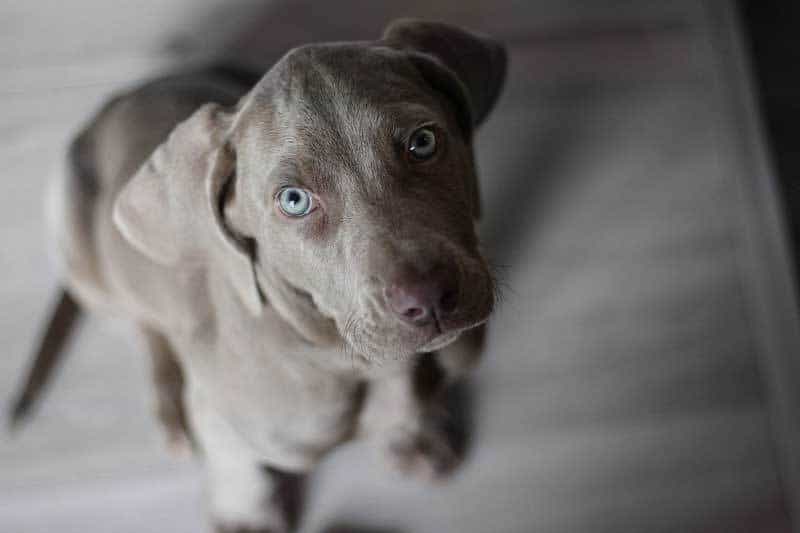
The AKC breed standard allows for blue-gray eyes, though most Weims have the soulful amber eyes we’re used to seeing. These jolly gray sporting dogs are energetic by nature and benefit from regular exercise, such as running. They’re smart dogs who’re eager to please, and they make excellent family pets thanks to their gentle nature.
Weims are relatively low maintenance when it comes to grooming, only requiring occasional brushing to remove dead hair as well as baths and nail trims. Keep an eye on his floppy ears, as this type of dog ear can be prone to infections.
While Weims are smart, they can be a little too smart for their own good. Invest in training while he’s young, and make sure he’s regularly challenged to ensure a well-adjusted pooch.
2. Husky
These northern blue-eyed cuties are also permitted to have brown eyes according to the AKC breed standard, though one of each and multi-colored eyes are allowed as well. His handsome coat doesn’t need much washing, but he sheds heavily twice a year and needs extensive brushing during these times.
The husky is intelligent and energetic, a disastrous pairing if he’s left unattended, under exercised, or bored. He makes a wonderful running companion, but as a cold-weather dog, he’s not a good pick for those in warmer climates.
Since he is strong-willed, he should start training early and have regular mental stimulation to avoid issues.
3. Shetland Sheepdog
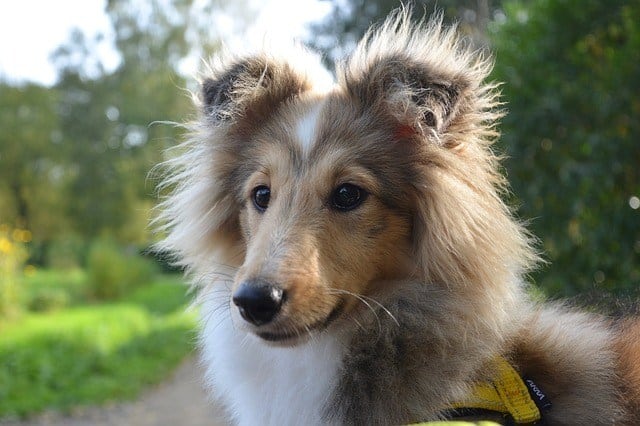
Blue eyes are rare in Shelties but are allowed by the AKC in blue merles.
These smaller herding dogs are very intelligent and thrive in obedience and agility trials. This makes him easy to train, but he should be kept busy to promote good behavior. Those with smaller animals should think carefully before adding a Sheltie (or even a Sheltie mix) to the fam, as his herding instincts give him the urge to chase.
His luscious coat requires frequent brushing to avoid tangles, and he sheds regularly, leaving tumbleweeds around the house. The hard work is worth the effort, however, as the Sheltie is a wonderful family companion.
4. German Shepherd Dog
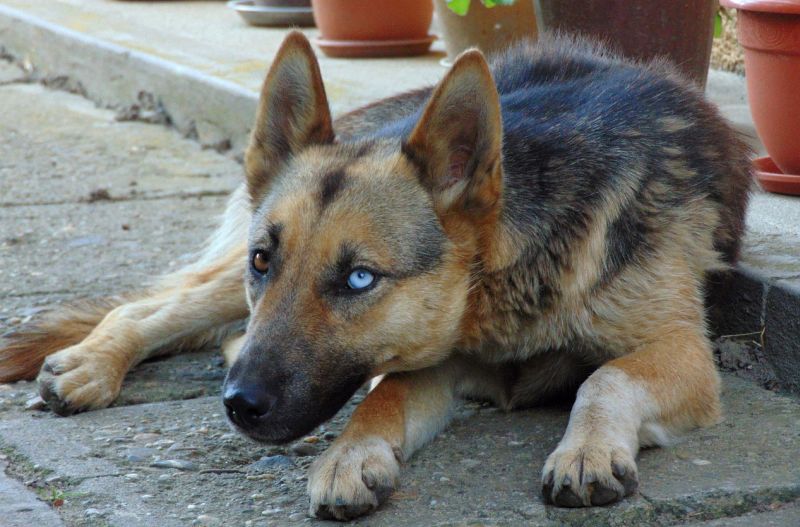
While AKC standard calls for his eyes to be as dark as possible, you can occasionally find a blue-eyed or parti-eyed German shepherd dog. He’s handsome either way, and with his elegant double coat, he’s a pup that always turns heads. It takes work to look this good, however, so prepare for regular brushing to remove excess hair and two heavy periods of shedding a year.
German shepherds are renowned family dogs with a playful nature, but that energy needs an outlet with daily exercise. He’s a challenge-loving canine that excels in seemingly every task you give him, from obedience to tracking.
His intelligence is world class, though he will test you if given the chance. For this reason, early training is a must.
5. Dalmatian
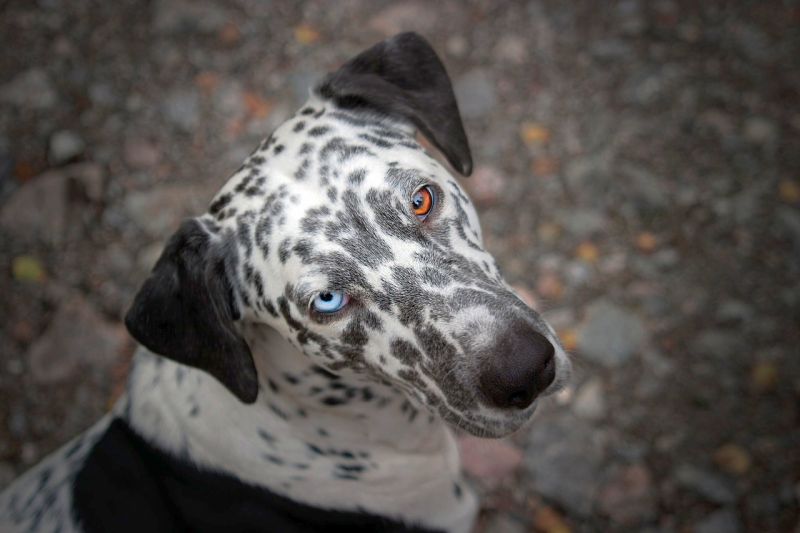
These spotted pooches can have blue, brown, or combination eyes per the breed standard. Added to his eye-catching spots, he’s a standout in the dog world.
But while he’s a looker, he can also be a handful, so keep positive yet firm training at the forefront from an early age to avoid ongoing issues. He has a great deal of energy that lends well to running beside a jogger or biker. He can be a good family dog too, but early socialization is essential to prevent a standoffish attitude with guests.
Dalmatians shed regularly, but regular brushing can reduce hair around the house. His short coat does not require frequent washing, either. Health concerns are prevalent in Dals, however, so choose your breeder (and dog food) carefully.
6. Border Collie

Any eye color is acceptable per the border collie breed standard, but blue is preferred on merles only. His coat colors and patterns are just as diverse, with merle and two-tone the most commonly seen. His medium-length coat sheds seasonally, but it requires brushing several times a week to prevent matting.
Border collies are energetic and intelligent, making them excellent candidates for agility, flyball, and more. His gentle nature lends well to life with kids, though regular exercise and mental stimulation are musts to avoid stress and misbehavior.
His eager-to-please ways shine in working roles, and he remains the farm dog of choice around the world.
7. Australian Shepherd
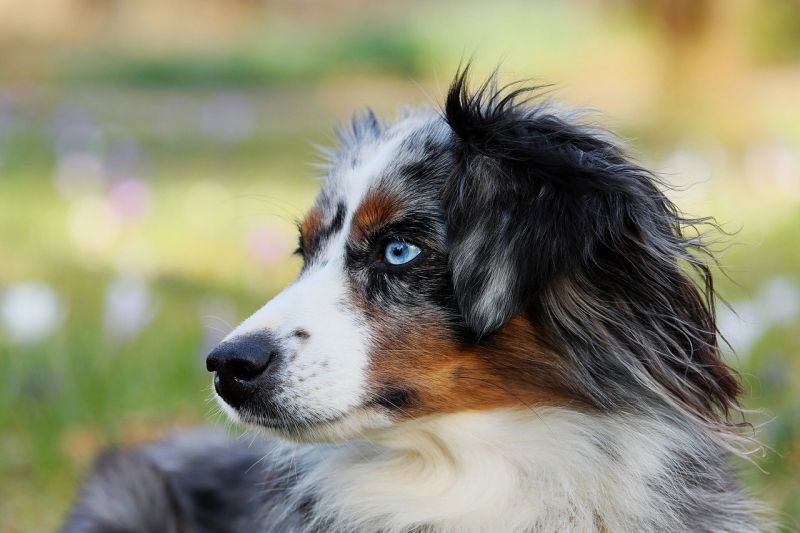
Blue eyes are common in Aussies and are allowed by the breed standard along with brown, amber, and combinations of either color. A wide assortment of coat patterns are allowed too, and his medium-length coat is wavy and surprisingly easy to care for, only needing weekly brushing and occasional bathing.
Aussies are one of the best breeds for agility, as his energy and intelligence are hard to match. With that in mind, prospective owners need to understand that Aussies require daily exercise.
Aussies are eager to please, however, and their affectionate natures usually make them beloved family members in no time.
8. Dachshund
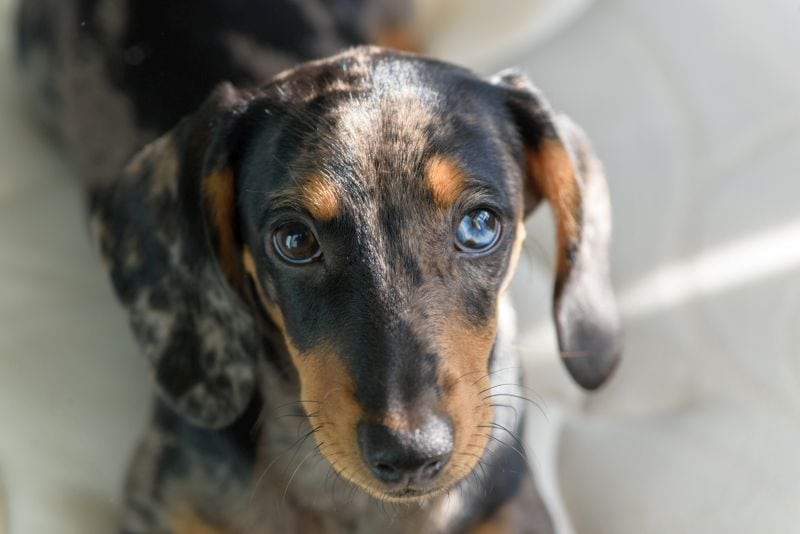
The AKC standard might call for dark eyes, but blue eyes appear in dachshunds, especially those with dappled coat patterns.
Doxies come in several coat patterns and textures, too, including smooth, wired, and long. Each requires weekly brushing and all shed regularly. Wire-haired doxies need special stripping several times a year to remove dead hair, however, while long-haired pups need extra brushing around the ears and tail to prevent tangles.
Doxies are confident little clowns that are playful as can be, but they have a stubborn streak that can make training (especially house training) a challenge. Remain patient and stick to consistent but positive training for a well-rounded little wiener dog.
Because of his size and short legs, he doesn’t need much exercise, but you must use care around stairs, as his long back can be prone to injury.
9. Cardigan Welsh Corgi
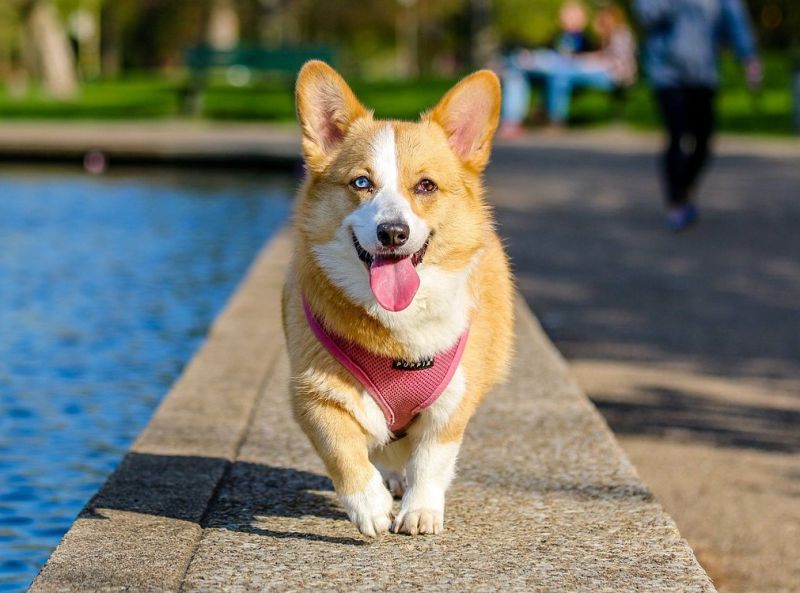
Blue and parti-eyed Cardigans are acceptable in merles according to the AKC, along with a host of awesome coat color combinations.
Distinguishable from his close cousin the Pembroke Welsh corgi by their long tail, the Cardigan has a thick coat that needs weekly brushing to remove dead hair. He sheds regularly, and it increases seasonally as the weather changes.
Cardigans are affectionate and loyal, making them ideal family companions. He has an happy-go-lucky attitude and playful nature. Paired with his energy, he’s an excellent companion for strolling around town or playing fetch in the backyard.
Like the dachshund, he has a long, low build, which means special care should be taken around stairs.
10. Australian Cattle Dog
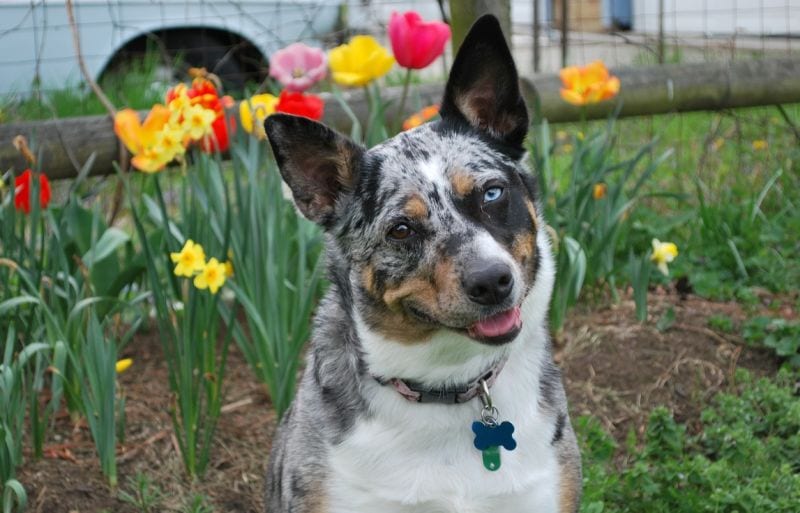
The AKC prefers for this all-around athlete of the dog world to have dark brown eyes, but blue eyes pop up occasionally.
His handsome ticked coat needs little maintenance, but regular shedding goes hand-in-hand with cattle dogs.
The real care with cattle dogs is tied to their energy, as these working dogs need daily exercise and tasks to stay out of trouble. Signing your cattle dog up for obedience or agility activities is an ideal way to burn off his excess energy.
Training can be a challenge despite the cattle dog’s intelligence. This breed is strong-willed and can be reserved with strangers and other dogs, so early intervention and socialization is key to a happy and balanced cattle dog. A high prey drive is another concern, requiring you to teach your cattle dog proper leash manners from an early age to ensure peaceful walks.
11. Great Dane
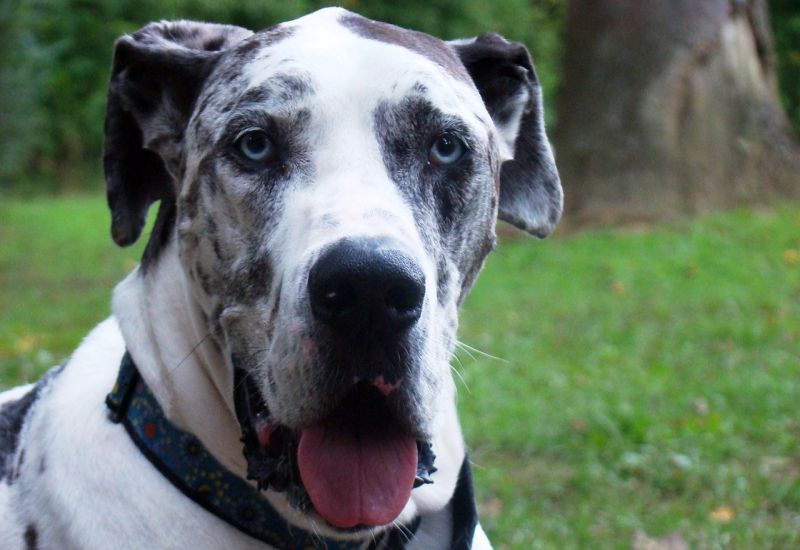
Merles and harlequins are the only coat patterns allowed to have blue eyes per the breed standard, but either way, Danes are handsome giants with hearts just as large.
Originally used for guard-dog work, these lovable hunks have a bit of energy to burn that can be worked out through daily walks. They thrive at weight-pulling and tracking too, which puts the breed’s working roots to the test.
Danes are best-suited for homes with older children due to their size, but early obedience training is a must while they’re still small enough to handle. One of the largest breeds, they’re also one of the most stubborn, so make sure you keep treats handy for reward-based training.
This breed is prone to bloat, a life-threatening twisting of the stomach, requiring prospective owners to educate themselves on how to reduce the risk through special feeding and exercise practices.
12. Catahoula Leopard Dog
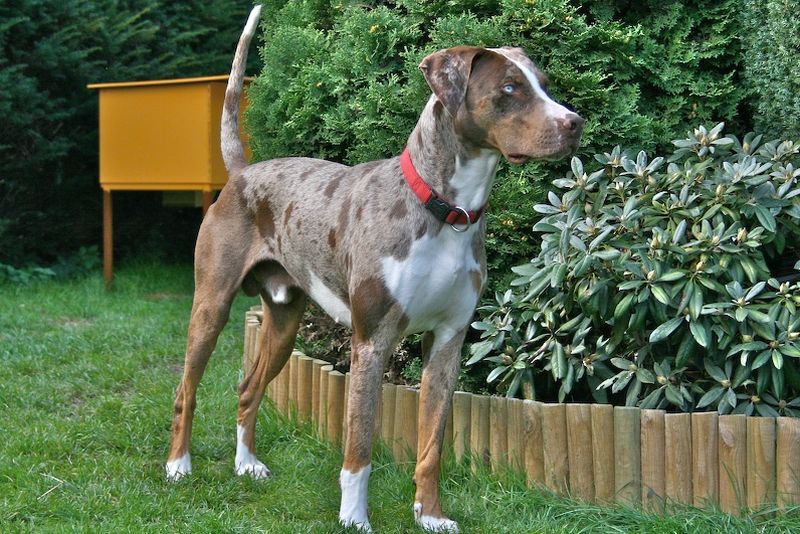
Catahoulas are the chameleons of the dog world, coming in a multitude of coat and eye colors, including blue and parti-colored.
These all-American doggos are striking with their multi-colored coats, but they are not a good choice for novice dog owners. Catahoulas are prone to being territorial and independent, so early training is essential for these canines. The breed’s high energy level requires a great deal of exercise and attention, so busy families should also look elsewhere. If you’re an avid jogger, however, this may be the breed for you.
Grooming your Catahoula is easy, as his short coat only needs occasional brushing and baths. His beautiful coat sheds regularly, but not as heavily as other breeds.
Health problems can be a concern for this breed, so research breeders thoroughly to ensure you bring home a healthy puppy free of hip dysplasia and eye problems.
13. Cocker Spaniel
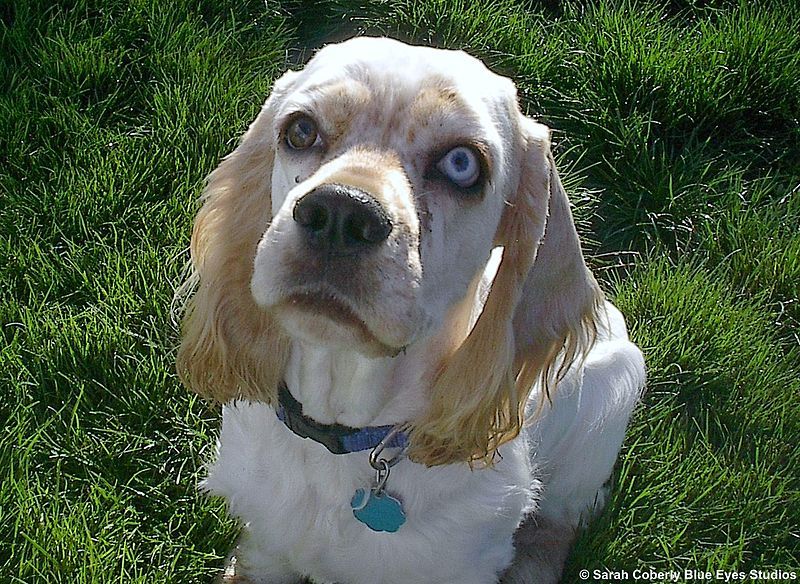
Blue eyes may be a disqualifier for the AKC, but the sparkling shade appears sometimes in cockers.
This medium-sized sporting breed is perennially popular with pup parents–and with good reason. Cockers are naturally playful and eager to please, providing years of companionship in the field and at home.They can easily go from agility class to the couch, serving as a loyal lapdog at the end of the day.
While the cocker temperament can be bright, they can be snippy with children if not introduced to tiny humans from an early age. His long, flowing coat requires brushing daily if kept long, but regular clipping can reduce this to several times a week instead.
This is a very outgoing breed that’s easy to train, making them an excellent pick for novice owners.
14. Alaskan Klee Kai
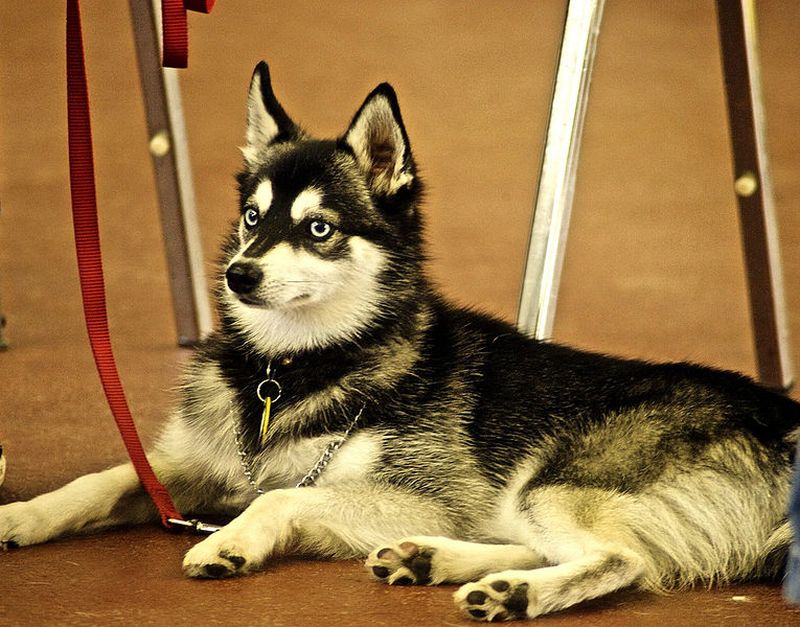
Resembling a pint-sized husky, the Alaskan Klee Kai commonly has blue eyes, which is acceptable by UKC standards.
This tenacious spitz has taken the agility world by storm with his high energy and excitement. He requires more exercise than most small breeds, and due to his high prey drive, and he should never be trusted off leash. This dog can be vocal and barks a lot too, so he may not be ideal for apartment living.
These entertaining little guys are affectionate and playful, making them good family dogs for those with older kids. The Klee Kai sheds frequently, but his coat can be kept handsome and shiny with regular brushing to strip away dead or loose hair.
15. Old English Sheepdog
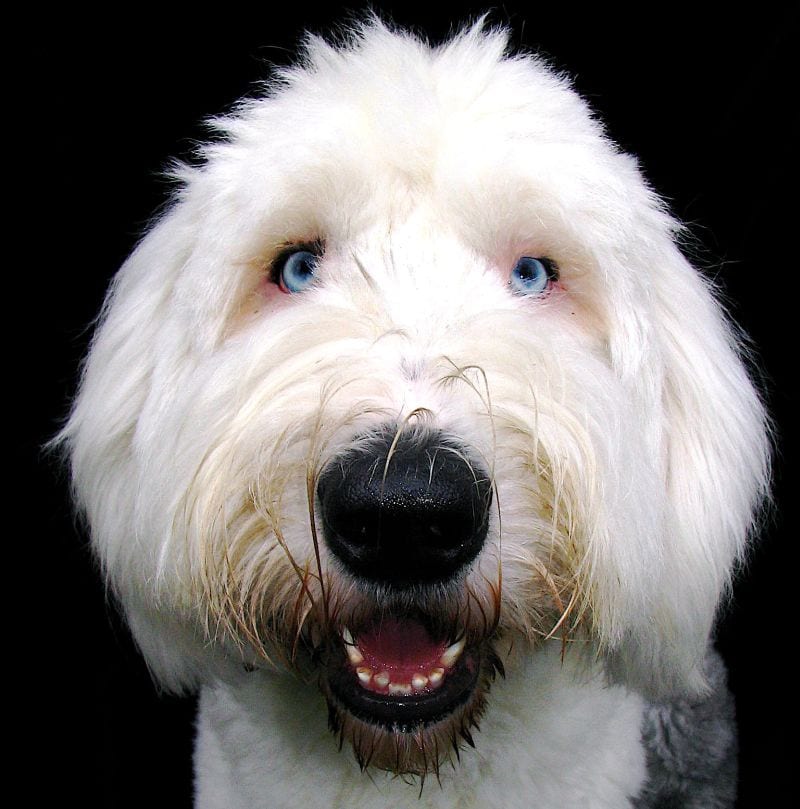
Per the AKC standard, OESs may have blue, brown, or one of each eye color. When these British chaps sport blue eyes, the hue is often lighter than the blue eyes of other breeds.
These fluffy pups have a dense double coat that is a lot of work to maintain. If kept long, expect to brush your sheepdog several times a week to prevent matting. Those who keep sheepdogs as pets rather than show dogs typically opt to keep their feet and backside trimmed short to avoid messes.
Bred to work livestock, OESs require regular exercise, but they don’t require as much as some other herding breeds. Your sheepdog will need training from an early age, especially focused on socialization since the breed can be selective with people and animals.
This is one of the more stubborn breeds, so novice dog owners should look elsewhere.
16. Neapolitan Mastiff
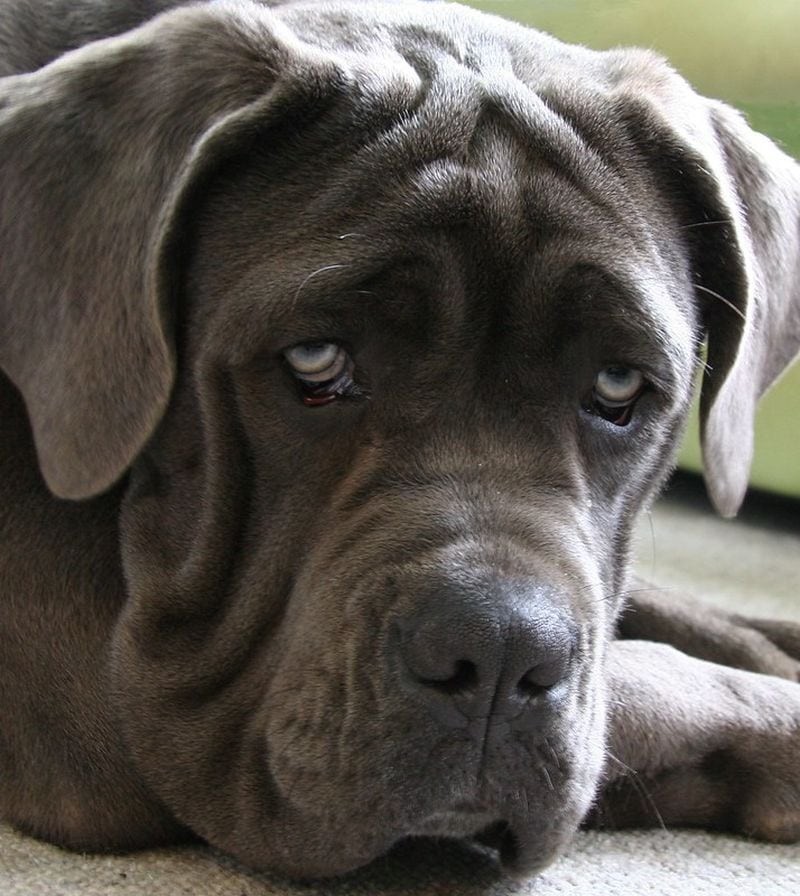
A pair of baby blues might be a fault with the AKC, but we think Neapolitans are handsome either way.
A colossal guardian breed with wrinkles for days, the Neapolitan mastiff is still relatively rare compared to others. He’s strong, confident, and independent, making him a no-go for newbie dog owners. He requires training from an early age, as the breed can be territorial and stubborn. Maintain a positive training atmosphere with lots of treats. The breed may be large, but he’s a big sweetie at heart.
Neapolitans may be lazy around the house, but they require regular exercise to ward off joint stiffness and obesity. Your pooch will need regular baths, but his short coat doesn’t require much brushing. These mastiffs drool heavily, however, so keep a towel handy to wipe your dog’s face as needed, and use a spill-proof water bowl to avoid messes!
17. Shih Tzu
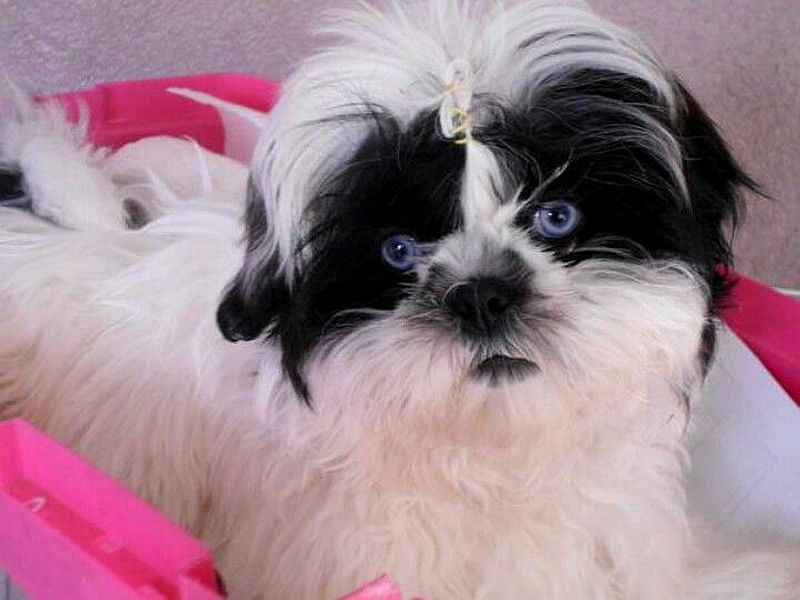
This world-class lapdog may receive a fault from the AKC for light-colored eyes, but the shades occur occasionally among shihs.
Best-known for their flowing coats, shihs need daily brushing if you opt to keep their coat long. You can groom it shorter into a so-called “puppy cut” for easier maintenance, which reduces brushing to a few times a week. Shihs aren’t frequent shedders, so you won’t need that lint roller as often as you might with other breeds.
These small fries pack a load of personality despite their size and are often as entertaining as they are adorable. Compared to other small dogs, they’re also one of the best for families with kids.
Your shih may be tricky to train, so start early and remain positive but consistent to avoid any issues. He is naturally playful, but the breed’s energy needs can be met with a daily walk or indoor play.
18. Boxer
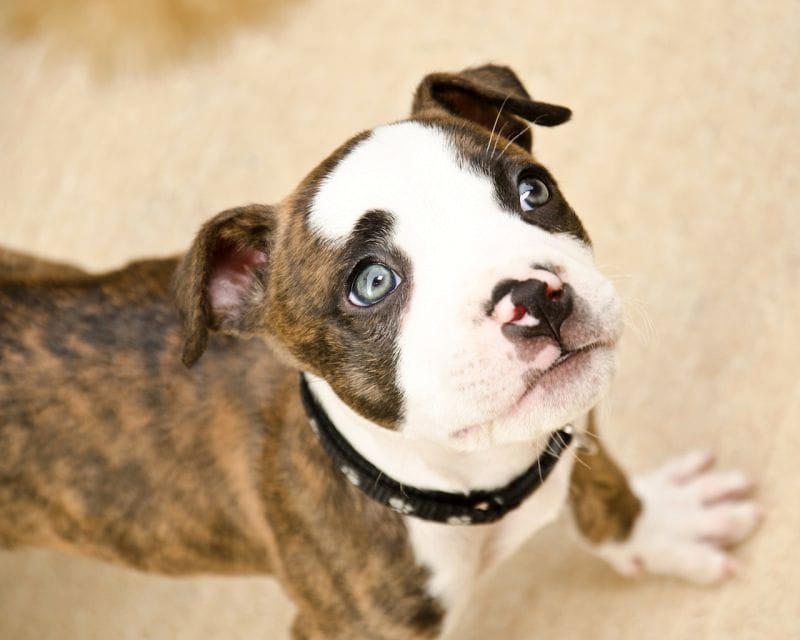
Dark eyes are the only ones listed on the AKC standard, but blue eyes occur occasionally in boxers. You may also see one blue eye and one brown eye, as seen in this cutie.
Boxers are beloved for their goofy nature, and their happy-go-lucky ways make them wonderful family dogs. He’s an active pup but bouncy, so make sure you establish manners early on to avoid a large, jumpy dog.
Boxers are simple to care for in terms of grooming, with their short coat only requiring occasional brushing and bathing. He is sensitive to extreme cold and high temperatures, so monitor him when the weather changes.
19. Pit Bull
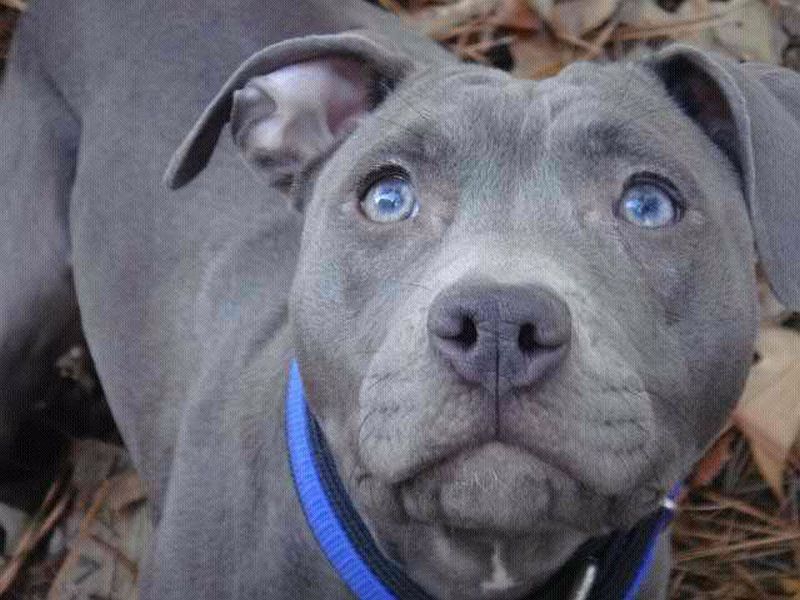
While blue eyes are found in the breed, the UKC standard gives a serious fault for a set of baby blues. Every other eye color is deemed acceptable, but we think blue is cute as can be too.
Pitties are a high-energy breed with a strong personality, so they require an active owner who can lead. That said, positive reinforcement is a must, as pit bulls may look tough, but they’re big softies inside.
His short coat is easy to care for, though his regular shedding may dust your furniture with spiky hairs. He is prone to allergies, however, so keep an eye out for red ears or feet for signs of trouble.
Reasons Dogs May Have Blue Eyes
You don’t always need to be alarmed by a set of blue doggo eyes. The blue eyes result from a lack of pigment in the eye, just like you see in humans. Dogs can have blue eyes for several reasons, including:
- Blue gene: Like us, eye color is inherited in canines, which is why certain breeds like huskies commonly have blue eyes.
- Merle gene: The merle genetic pattern affects a dog’s coat, resulting in shades of white, blue, red, and more. This is also true of eye color. Merles often have blue eyes, a blue and a brown eye, or two-tone eyes.
- Albinism: This gene mutation results in a completely white dog that lacks pigment in the skin, hair, and eyes. Albinos always have blue eyes, and their skin has a strong pink coloring that’s more obvious around the eyes. It can be linked to blindness and deafness.
It’s also important to note that many puppies are born with blue or blue-ish eyes. However, most of these will gradually change to brown or amber.
While blue eyes are usually harmless, the color can occur later in life due health problems, such as:
- Cataracts: This condition causes a clouding of the cornea that can give eyes a gray, milky, or bluish appearance. Typically found in older dogs, cataracts are caused by age, injury, or disease, and can ultimately lead to blindness if left untreated. Surgery can remove cataracts.
- Corneal Dystrophy: The condition typically presents with cloudiness or haziness in one or both eyes. While this is typically harmless and doesn’t affect vision, a veterinarian should monitor for signs of ocular ulcers.
- Glaucoma: Caused by pressure in the eye, glaucoma can result in a bluish or gray hue to the eye. Treatment is necessary as the condition is painful and can result in the loss of the eye.
- Nuclear Sclerosis: This clouding of the eye is commonly found in dogs and may cause a bluish tinge in the eye of older dogs. It’s typically harmless and doesn’t require treatment, but you should consult your vet to rule out cataracts and other other ailments.
- Anterior Uveitis: A rare condition that causes clouding of the pupil, Anterior Uveitis can lead to blindness. Symptoms of AU are squinting in dogs or excessive eye discharge.
Do you have a blue-eyed pupperoni at home? What kind of pooch is he/she? Is it one of those listed above or something else? Let us know in the comments.
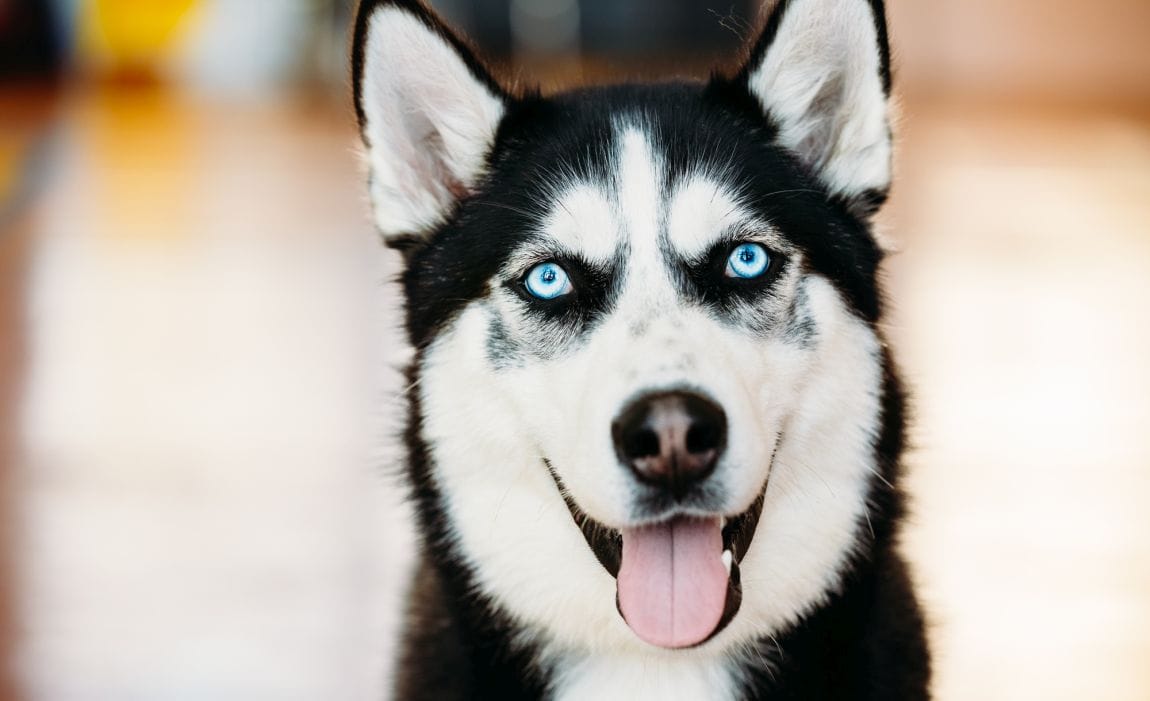

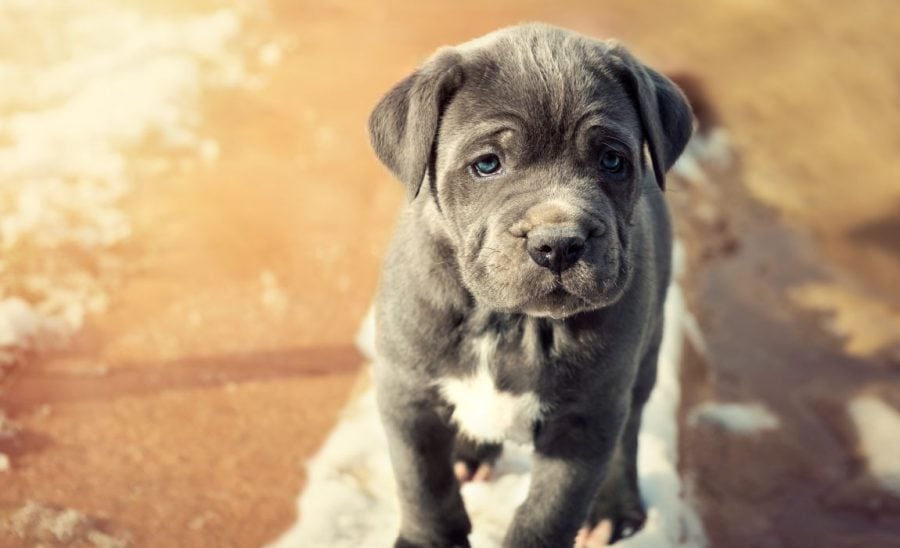


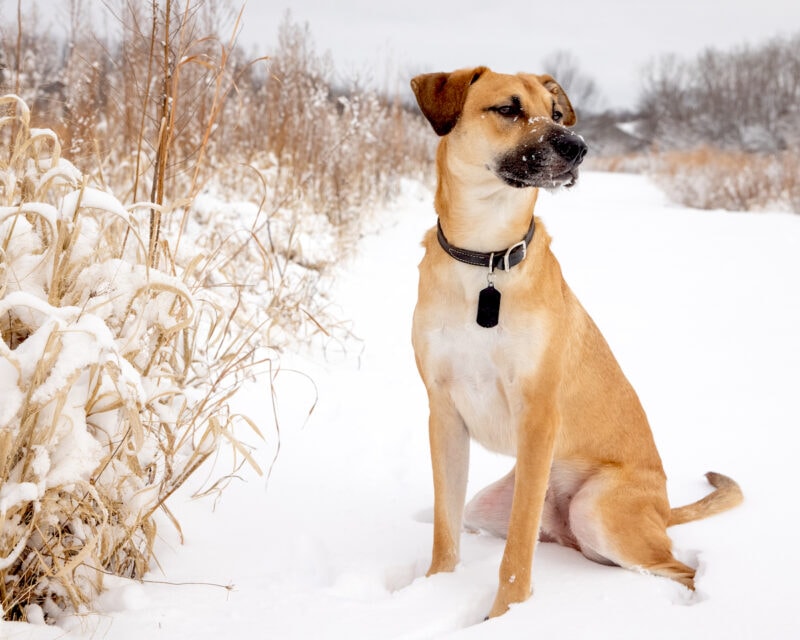
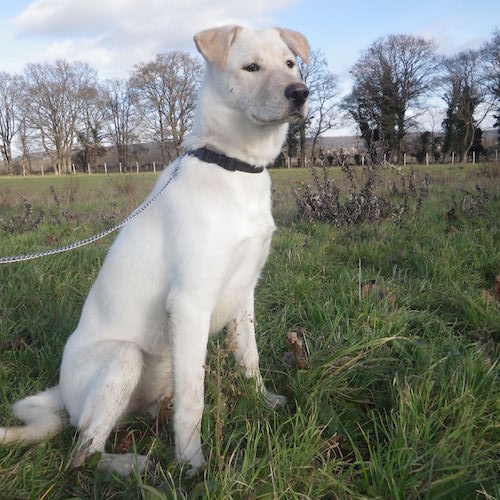
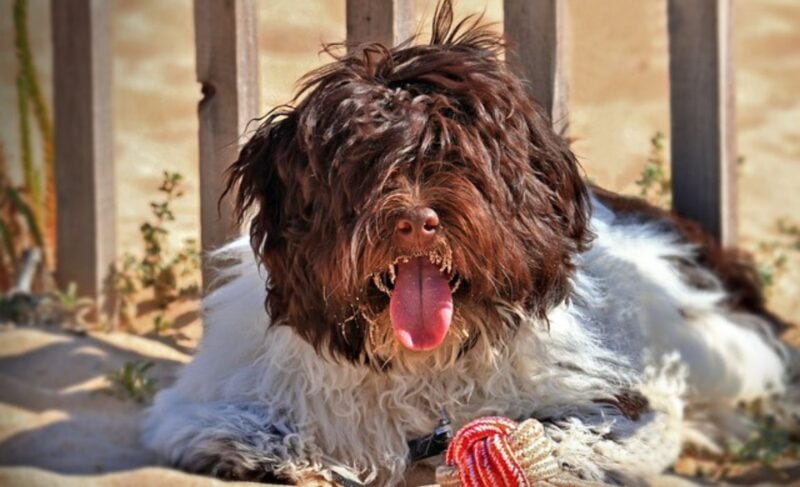
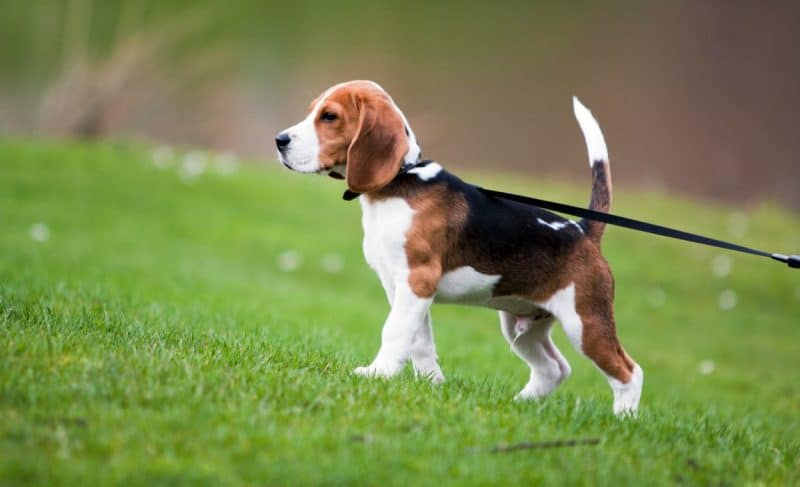
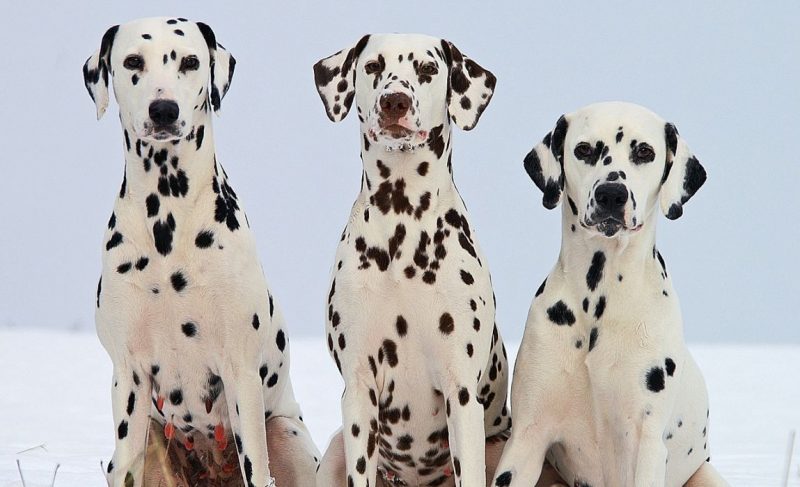
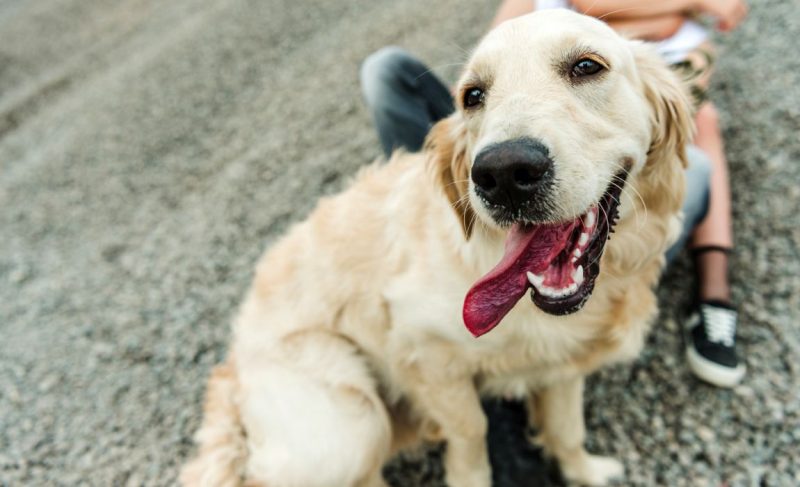
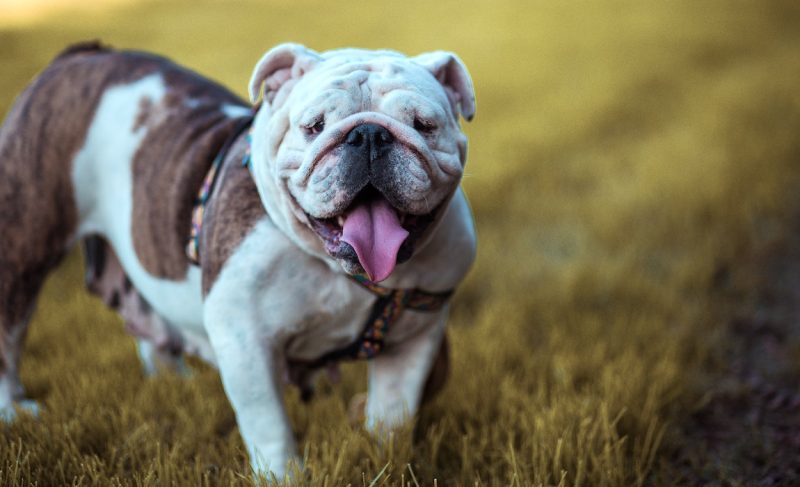

Leave a Comment